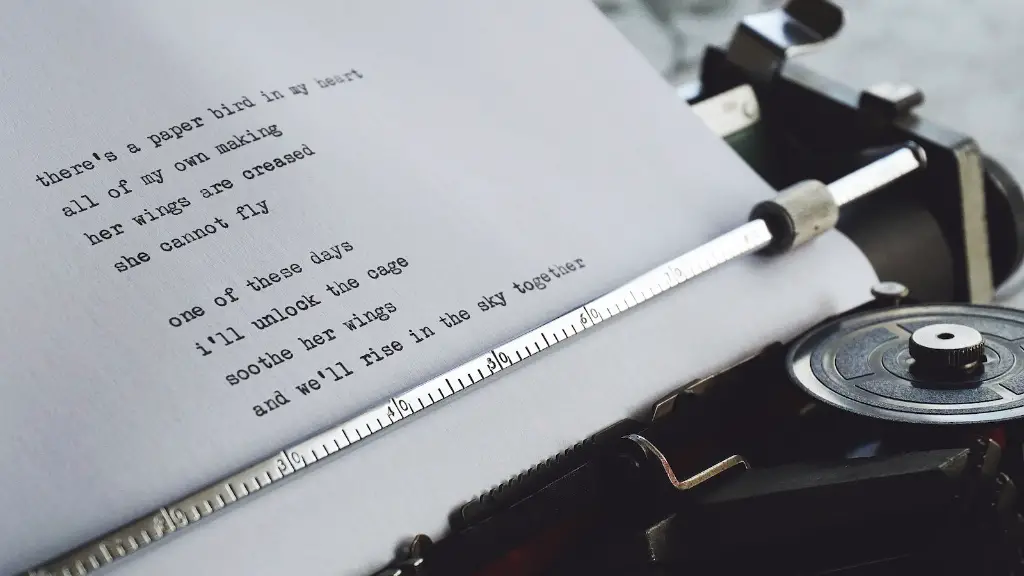The Role of Mood in Poetry
Poetry is a unique and highly expressive art form that conveys emotion, reflection and meaning. With its use of metaphor and symbolism, poetry often carries two main elements: language and mood. By creating an atmosphere, a mood, a poet can convey meaning and emotion to the reader in a very direct and powerful way.
Mood is an emotion or a feeling that permeates the poem and is expressed through literary devices such as imagery, simile, metaphor, personification, and so on. To understand mood, the reader must think about the lines of the poem and what feelings the words evoke. By looking at the words, the language and its effect on the reader, one can interpret the mood of the poem.
Mood can also be understood by looking at the poem as a whole. Consider how the poet presents the topic; look for words that suggest certain emotions; watch for clues about the writer’s attitude towards the topic. In this way, the reader can interpret the poem’s overall mood. For example, a poem about sadness may use phrases such as “the tears of the night” or “the rain of sorrow” to create a melancholy atmosphere.
In order to achieve this emotional impact, a poet may use words with connotative meaning that speaks to the reader on an emotional level. These kinds of words have multiple meanings and also carry emotional weight. Such words can be used to emphasize the mood of the poem and can help to create a strong connection between the poet and the reader. In addition, a poet may use language that is full of imagery to evoke a feeling. For instance, a poem about nature may use words such as “the sun was blazing” or “the breeze rustled” to create a particular atmosphere.
Using mood in poetry is an effective way to create an atmosphere and to communicate meaning and emotion to the reader. Through its use of language, imagery and connotative meaning, the poet is able to draw the reader into the poem, resulting in a powerful and lasting impact on the readers’ emotions.
The Variety of Moods in Poetry
The mood of a poem can vary, from positive to negative. It all depends on how the poet has chosen to write their poem. Positive moods would include joyful, optimistic, or triumphant. Negative moods might include sad, angry, or depressed. More subtle moods exist as well such as subtle, reflective, and mysterious. A poet can use these moods to express different feelings, emotions, and experiences.
The variety of moods found in poetry can help to create a multifaceted interpretation of the poem. By exploring various moods and their effects, readers can gain insight into the poem, while also expressing their own emotions and feelings. The use of various moods can help to convey the poet’s message in a way that is meaningful and understandable.
When exploring mood in poetry, it is important to recognize that the mood of a poem may change throughout the course of the poem. For example, a poem may start off on a melancholy note, but by the last line, the poet may have transitioned to a more uplifting mood. By being mindful of the changing moods in poetry, one can gain a deeper understanding and appreciation of the poem.
The Impact of Mood on Reader’s Experience
The mood of a poem can have a powerful impact on the reader’s experience. By evoking a particular emotion, poets can draw readers in to the story or concept of the poem and help them to gain a deeper understanding of the poem’s individual elements. Moods can also be used to speak to the reader on an emotional level, allowing the poem to connect with their own experiences.
Mood can be used to set the tone and atmosphere of a poem and can be used to great effect to create a certain feeling. Through mood, a poet can create a certain atmosphere in which the reader can emotionally resonate with the poem, making it more meaningful and enjoyable.
Mood can also be a great tool for storytelling and conveying messages. By carefully choosing the words and creating a certain atmosphere, the poet can make a powerful and lasting impact on the reader. By making an emotional connection, the poet can better communicate their own experiences and messages to the reader.
The Power of Mood in Poetry
The power of mood in poetry should not be underestimated. By carefully crafting the mood and atmosphere of a poem, poets can create a powerful and lasting connection with the reader. This can help to convey the poet’s message in a deeply meaningful way and can evoke powerful emotions and understanding.
When exploring mood in poetry, it is important to recognize the power of language, imagery, and connotations. By understanding how different words and phrases can evoke certain emotions and feelings, poets can make a powerful connection with the reader and create a lasting impression.
Although many people may overlook mood when studying poetry, it can be an important and powerful tool for conveying messages, stories, and emotions. For this reason, it is important to appreciate the power of mood when reading a poem and to recognize the impact it can have on the reader’s experience.
The Importance of Mood in Poetry Analysis
When studying poetry, it is important to recognize the role that mood plays in understanding the poem. This is especially important when attempting to analyze the poem in order to understand its meaning. By understanding the mood of the poem, one can begin to gain insight into what the poet was attempting to convey and how they were attempting to convey it.
Mood is an important factor when looking at the poem as a whole. By taking the time to consider the mood of the poem and its effects on the reader, one can gain a deeper understanding of the poem’s message and its individual components. This can be a valuable tool for interpreting the poem and analyzing its meaning.
Mood can also help to convey the poet’s intentions and can be a powerful tool for conveying complex ideas and emotions in a subtle and meaningful way. Mood can help to bring the words of the poem to life and to create a deep connection between the poet and the reader.
Conclusion
Mood is a powerful tool for conveying emotion and meaning in poetry. Through its use of language, imagery, and connotations, mood can evoke powerful feelings, create atmosphere, and communicate messages in a meaningful way. Mood can help to connect the poet to the reader in an emotional and lasting way, making poetry a powerful and meaningful form of art and expression.




